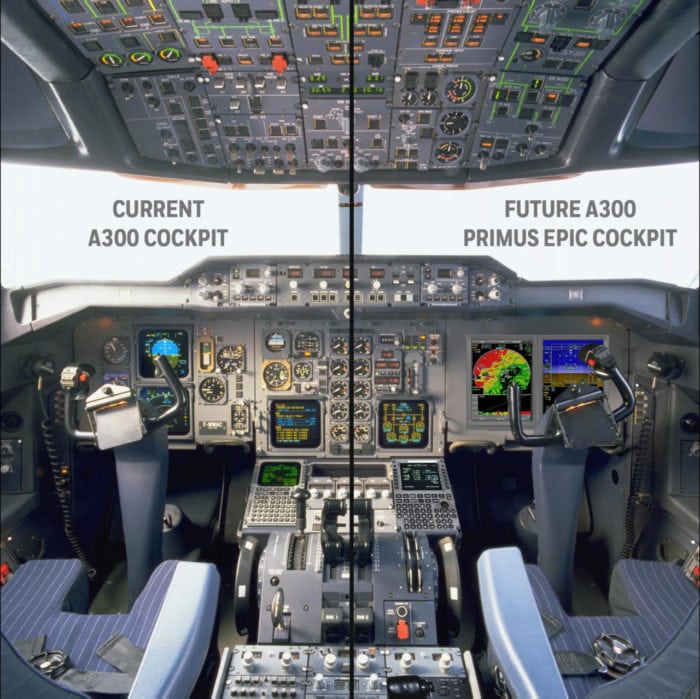
A before and after view of what the UPS A300 cockpits will look like. Photo: UPS.
UPS is revitalizing the cockpit avionics and embedded computing architecture of its Airbus A300 aircraft with a new flight management computer, central maintenance system and better processing power. The international air cargo carrier held a press conference Monday to discuss the upgrades to its A300 avionics, after having announced a major overhauling of its Boeing 757 and 767 cockpits.
Kevin O’Hara, avionics and systems engineering division manager at UPS Airlines, said the carrier first started considering the change to A300 avionics several years ago. Under an agreement with Airbus and Honeywell, UPS will add an advanced flight management system (FMS), a new integrated standby instrument system, a central maintenance system and new liquid crystal displays in place of the A300’s current cathode ray tube (CRT) cockpit displays. Airbus will serve as the prime integrator for the upgrade of 52 total UPS A300s.
O’Hara also mentioned that UPS was considering purchasing a brand new air freighter-configuration aircraft, but did not see any new options available on the market. While neither Airbus nor Boeing have introduced any new air freighter types in recent years, Lockheed Martin recently rolled out its first new commercial freighter version of the C-130J Super Hercules, the LM-100J, out of its factory in Marietta, Georgia.
Olivier Criou, head of Airbus A300 programs for the customer services division of Airbus told reporters that the upgrade will involve modification of the electrical cockpit panels and the integration of new racks and wiring to support some of the new avionics technology being added.
One of the unique aspects of the A300 avionics upgrade is that it uses processor cards installed in a cabinet rather than individual components for aircraft functions, such as the FMS, ACARS and CMS, according to Carl Esposito, president of electronics solutions at Honeywell Aerospace. New aircraft functionality can be added in a more flexible way over time with software loaded onto the processor cards.
“With this avionics system being software upgradeable over time as new features, functions and capabilities are developed across the Primus Epic family of avionics, we can apply them to this fleet of aircraft to keep them up to date and modern,” said Esposito.
The new avionics package is based on the Honeywell Primus Epic avionics suite and will also add a new Honeywell RDR 4000 weather radar system to the A300s.
By adding the new avionics, UPS will have a satellite-based augmentation system-capable GPS, as well as the ability to fly LPV and RNP AR routes.
Engineering for the project is already occurring, said O’Hara, and UPS expects to earn certification on the upgrade by 2020, with modification for the entire A300 fleet to be complete by 2022. The first A300 will be sent to Airbus for modification in 2019. In addition to integrating the overall engineering, Airbus will supply a modification service bulletin and modification kit including all required parts on in-service A300s moving forward.